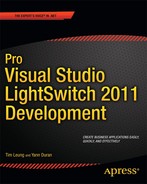Book Description
Microsoft Visual Studio LightSwitch 2011 is a rapid application deployment tool that lets power users and administrators build data-centric business applications for the desktop, cloud, and Web in just a few clicks, with no code required. But more advanced developers and business users will hunger for more: how do you design complex screens? How do you query data using LINQ and other syntax structures? How do you secure your application?
Pro Visual Studio LightSwitch 2011 Development answers these questions and more as authors Tim Leung and Yann Duran—both awarded Microsoft 2011 Community Contributor Awards for their LightSwitch expertise—cover this breakthrough product and its operations and structure under the covers.
For serious developers building, enhancing and deploying advanced business applications using LightSwitch, Pro Visual Studio LightSwitch 2011 Development is the guide for going beyond the "click-and-you're-done" interface, while still maintaining the elegance and convenience of rapid application development.
What you'll learn
With Pro Visual Studio LightSwitch 2011, learn how to:
Add visibility through with Relationships and Details screens
Use customized queries, sorts and filters, and reporting
Customize displays via user controls
Use multiple line-of-business data sources to aggregate reports
For more advanced LightSwitch users, see how to:
Handle events in code and debug applications
Master the intricacies of complex user interface design
Secure your applications through authentication
Write custom .NET code to enhance LightSwitch
Deploy maintainable LightSwitch projects
Who this book is for
Pro Visual Studio LightSwitch 2011 is a book designed for any software developer who wants to take advantage of the rapid application deployment (RAD) experience offered by LightSwitch. It is ideal reading for those wanting to build and design applications correctly from the onset.
Those who have grasped the basics of LightSwitch and are looking to do more will benefit greatly from this book. Anyone struggling to design complex screens and queries in order to meet user requirements will find the answers in this book.
Table of Contents
- Title
- Contents at a Glance
- Contents
- About the Authors
- About the Technical Reviewers
- Acknowledgments
- Foreword
- Introduction
- Part 1: LightSwitch Concepts
- Part 2: Working With Data
- Part 3: Interacting With Data
- Chapter 7: Creating and Using RIA Services
- Chapter 8: Creating and Using Screens
- Chapter 9: Creating and Using Custom Controls
- Chapter 10: Creating and Using Extensions
- Understanding the Need for Extensions
- Finding Extensions
- Installing Extensions
- Creating Extensions
- Creating the Extension Library Project
- Understanding Extensions
- Understanding Theme Extensions
- Understanding Shell Extensions
- Understanding Screen Template Extensions
- Understanding Control Extensions
- Understanding Business Type Extensions
- Understanding Data Source Extensions
- Debugging Extensions
- Distributing Extensions
- Summary
- Part 4: Getting Data Out
- Part 5: Securing Your Application
- Part 6: Deployment
- Appendix A: Culture Names
- Appendix B: LINQ Query Operators
- Index
